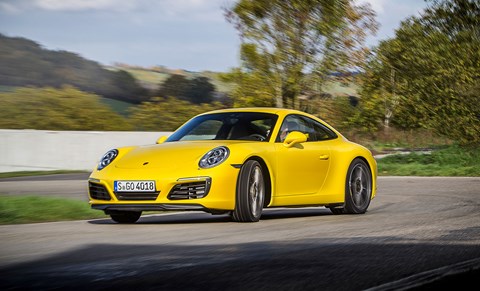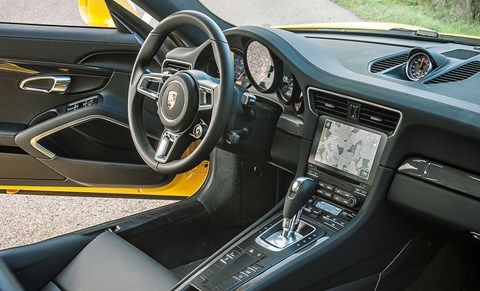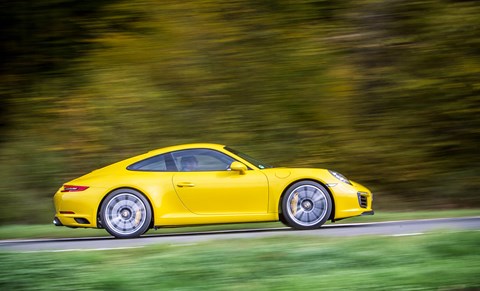► We drive the all-new Porsche 911 Carrera S
► Now all 911s are turbocharged…
► Faster, brawnier – but is it better?
To call the 2016 911 a mid-life facelift is like saying gender-swapping boxing promoter Frank Maloney popped in for a nip/tuck. In exchanging its legendary naturally aspirated flat-six for twin-turbo power Porsche has subjected its most precious asset to life-changing surgery. Life-changing is one thing, life-threatening quite another. This is our first chance to check the 911’s post-op pulse.
Our canary yellow test car is a Carrera S with an exclamation mark. Make that two exclamation marks. It runs on the widest available rims, 20-inchers shod with 245/35 rubber in the front and with even lower section 305/30 Pirelli P Zero tyres in the back. Also on board are carbon ceramic brakes, rear-wheel steering together with active anti-roll bars, extra-loud dual-mode exhaust, double-clutch PDK transmission and the game-console-inspired Sport Chrono pack. Seating is via one-size-fits-some racing buckets which grab you by the hip and by the shoulder like a professional wrestler. I snap the banana yellow belt into its buckle, select Normal on the drive mode selector and fire up the engine, the sound of which could make or break this car. The five round dials and the small touchscreen monitor spring to life. We’re ready to go.
Porsche built its first turbo engine in 1974. It was the mean heart of an even meaner car – lazy, explosive, melodic and deafening, dependent on where you were on the rev ladder. Four decades later, the engine has matured from a simple muscle-building tool to a sophisticated all-purpose weapon, producing 414bhp despite having shrunk from 3.8 litres to 3.0. With 369lb ft of torque available at a much more leisurely engine speed, and fuel economy improved by about 10%, surely this will be a case of love at first drive? Yes and No. The left side of the brain is fire and flames for the benefits of progress. The right side of the brain, however, is not entirely convinced. Some of the noises the new engine makes are irritatingly different – the way it unravels grunt and urge is less spectacular. It changes the character of the car.

Hearing is the sense sports cars stimulate with particular intensity, and the outgoing normally aspirated flat-six is a master musician that always got you hooked the very first time the gearlever struggled through the gate. Its riveting sound pattern reflected its exotic engineering concept. Because of the horizontally opposed pistons, it needed voluminous lungs and a free-flowbreathing system to accelerate the mixture’s long travel from the air filter to the combustion chambers. The routing of the exhaust had to follow similar principles, and the ability to rev freely was required to maximise the momentum. The resulting sound was an unmistakable raucous chainsaw working noise which flapped its phonetic wings loudest above 5500rpm, and even when noise regs forced a change the motor’s tone of voice altered only like that of a boy turning into a man. It always remained true to its basic phonetic code.
The new 911 – call it 991.2 – has a different engine melody. Not nearly as different as JS Bach is from Loussier’s Play Bach but it is, to use a technical term, remixed. Take the idle speed, which used to be a prelude to the Wagnerian thunder that was about to follow. It is more subdued now, socially more acceptable in a neighborhood keen of hearing, and bang in line with the strictest dBA regulations. Now stroke the pedal but don’t yet pump it to turn up the volume a notch or two, and listen to the turbos probing their vocal chords, like a pair of highly tuned yet neatly muffled elevator motors. More throttle please to encourage the whole orchestra to kick in, dense and incredibly disciplined, loud but not blaring, a tightly woven musical act. It’s a modern tune, metallic yet extremely well coordinated, composed but emphatic enough, a new family member joining the family conversation. Only when you rev it harder – there are now an extra 500rpm to unspool – the familiar 911-speak will become truly intense and unmistakable. More Kaufmann than Villazon, yes, but definitely still one of the greatest living tenors.
We would be more critical of the new engine had Porsche not previously established an enclosure for the die-hards who adore the fine art of retro-engineering. These in-house skunkworks will continue to develop classics like the Cayman GT4, 911 GT3/RS and next year’s stealth 911R. In a small in-house sports car reserve run by Andreas Preuninger, non-turbo engines are encouraged to live on, as are manual transmissions and only the most basic driver aids. Purists can sleep tonight.

For the rest of us the new Carrera S (and the models that will follow) offers other tangible benefits at the price of a mildly tweaked personality. The key numeric advantages for the PDK-equipped model are 3.9sec for the 0-62mph sprint rather than 4.1, an average consumption of 36.5mpg instead of 32.4, and a 2mph higher top speed of 193mph. These data bring the Porsche even closer to rivals such as the Mercedes AMG GT-S or the BMW M6 Competition. But since they don’t make the 2016 911 feel subjectively faster, the electronic driver aids have been asked to delve a little deeper into their box of tricks – with debatable success.
Although the 911 has yet to be introduced with a designated eco programme for engine and transmission, the CO2 chasers did have a say in the calibration of the new Carrera S driveline. While start/stop is a given these days, this one cuts the engine early on the approach to a stop. The PDK transmission now features a coasting function which steps in when you lift off in certain driving conditions, but sadly not in Sport or Sport plus. Also conceived to save fuel at a leisurely pace is the virtual ‘between gears’ position, which manages the clutches of two neighbouring ratios until the driver decides whether to press on or back off. Even though the chip-controlled servants work smoothly and discreetly, committed users may be more impressed by the GT3-inspired reversed gearlever action when in manual mode. From now on, pull commands upshifts and push orders downshifts, Le Mans-style. Even though we are in the two-pedal version, the in-built synthesiser is happy to pretend heel-and-toeing and that blat-blat splutter under trailing throttle. Apparently, customers love such gimmicks. The same audience is bound to adore the overboost button in the steering wheel which arms all systems for the next 20sec. A kickdown function would have had the same effect, but marketing went for the full works including a hero mode countdown display in the binnacle to the right of the oversize rev counter.
That rotary switch with push button has been transferred from the 918 to the 911. It’s not as versatile as Ferrari’s manettino, and it won’t let you dial in a softer damper setting before tackling a bumpy C-road, but it does tweak the car’s main traits in four stages labelled Normal, Sport, Sport Plus and Individual. Depending on specification, this is an invitation to mix and match one’s favourite blend of drivetrain, suspension and exhaust settings. As before, the super-aggressive Sport Plus is only suitable for the racetrack or for timed hillclimbs, while Normal is a synonym for not interested. So, for maximum driving pleasure, stay in Sport and also try PSM Sport, which offers an interesting middle ground between guardian angel on duty and gone fishing. On cold rubber in single-digit temperatures, PSM Sport can be tantamount to Game Over, so it is absolutely essential to warm up the tyres before putting on the Hamilton mask. Like all 911s, the new C2S is quite sensitive to tyre pressures; minor adjustments can work wonders for the front end grip. Predictably, the ride quality deteriorates in proportion to the surface quality. The sports suspension, which stiffens up springs and dampers while lowering the ride height by 20mm, is in this context therefore a questionable extra.

Up to 30mph, the 911’s new rear-wheel steering tightens the turning circle by 400mm. Above 50mph, it enhances the directional stability. Nice to have, sure, but like the active anti-roll system, not an essential option. How about the standard manual transmission and the carbon-ceramic brakes, you ask? Well, despite the reduced effort and improved precision, the seven-speed ’boxstill is a challenge to dexterity, and the top four ratios are long enough to close that hole in the ozone layer all by themselves. True, those awesome multi-compound brakes cost as much as a royal mansion in Bangladesh, and they can be noisy when cold or stressed. In terms of effort, modulation and stopping power, however, the four yellow calipers under pressure are as physical as the world’s twistiest
rollercoaster.
Inside the 911 cabin it’s harder to spot the progress. You still need a coupe-shaped pseudo key to open the door, to start the engine via the ignition lock left of the steering column, and to remote-pop the bootlid. A modern magic wand entry system remains conspicuous by its absence, along with a head-up display, certain driver assistance features offered elsewhere, or less fussy ergonomics. Fact is, progress at Porsche typically manifests itself in other departments.
The upgraded connectivity is a big step forward for 911, however, if not a huge leap for mankind. After all, even seasoned index fingers still struggle with the tiny chocolate bar push buttons and the improved touchscreen which now boasts proximity sensors and up-to-date software. We like the new smaller-diameter multi-functional sports steering wheel, although it could do with longer shift paddles. Improvements are in the works, but they won’t come to market until the all-new Porsche 992 debuts in 2018 followed by a hybrid variant in late 2019.
Especially when compared to the last-of-line 911 GTS, the new Carrera S is less of a hardcore sports car and more of a wiry grand tourer. One look at the torque curve of the twin-turbo engine tells it all. While power delivery is almost eerily linear from idle speed to 6500rpm, the torque curve runs, as if drawn with the help of a ruler, absolutely flat all the way from 1700 to 5000rpm. That’s what artificial aspiration does for you, and that is where the 414bhp unit breaks new ground. Learning the virtues of this high-efficiency boxer takes a bit of time. At the end of the day, it is the mix of Sport and Manual modes that does the trick, together with certain mental adjustments. Sport is quite dedicated even with the gear selector stuck in Drive, but Manual is much more involving still. The driving technique aligns with every hour spent behind the wheel. First, you abandon superfluous downshifts. Next, you time upshifts less and less impatiently. Eventually, the emphasis will have shifted from nursing high revs to riding big momentum. This description may be somewhat black and white, but then the degree of assimilation is not merely parenthetical.

Older 911s were raw wah-wah tools demanding an almost digital driving style: give it stick, brake hard, shift down one or two gears, turn in with a vengeance, easy on the throttle toward the apex, then pedal to the metal again. The sold-out GT3 is still such a shirt-sleeved type, a gifted figure-skater, quite loose yet in total control when it matters. In contrast, Carrera S, which has ceded that last inch of pre-turbo throttle sharpness yet not succumbed to turbo lag as such, prefers wider radii, smoother blacktop, faster turf, a more balanced tempo. Its electric steering, the arrival of which caused almost as much angst among Porschephiles as this turbo era, seems to suit the 991.2 better, its virtual heft seeming more malleable. Maybe we’re simply adjusting. Maybe we simply need to acknowledge that adjustment is part of life.
But make no mistake, this is a wonderful car in its own right. You may play silly boy when you must, but in truth this is a 911 for grown-ups. That’s grown-up as in a consciously consummate pace, a precise and progressive line, an intuitive interaction between input and response. The 911.2 is not only quicker, faster and more frugal than the model it replaces, it’s also a more rewarding drive, as long as you prefer fluidity, balance, style and tactility over brashness and bravado. Which is another way of saying that it is more accessible and more forgiving. It moves the game on in an inevitable direction which leaves ample room for all those upcoming back-to-the-roots Porsches whose predecessors we haven’t, in all honesty, quite got over yet. Kicking an addiction takes time. Eighteen years on we’ve only just got over the shock of the 911’s shift to water-cooling!
The specs: Porsche 911 Carrera S
Price: £85,857
Engine: 2981cc 24v biturbo flat-six, 414bhp @ 6500rpm, 369lb ft @ 1700-5000rpm
Transmission: Seven-speed PDK auto, rear-wheel drive
Performance: 3.9sec 0-62mph, 193mph (limited), 36.5mpg, 174g/km CO2
Weight: 1420kg
On sale: Now (for 2016 delivery)

Up against
Better than: Mercedes AMG GTS. Still has that unique rear-engine balance
Worse than: 911 Carrera S 991. For now, at least, we prefer nat asp
We’d buy: 911 GT3. No turbo, no compromise, nothing can touch it
Love: Good-looking, built to last, supreme dynamics, street cred, wide range
Hate: Almost too sensible for a 911, ride/composure on rough roads, outmoded ergonomics
Verdict: They haven’t spoiled it, but they’ve made it grow up. Boo!
Rating: ****
Watch the video! See Ben Barry putting the new 911 through its paces on our interactive iPad edition